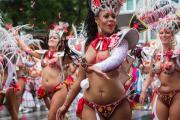Carnival in England. Notting Hill Carnival - traditions of Caribbean culture
The Notting Hill Carnival can compete with its counterpart in terms of entertainment, and in terms of attendance - with any European costume procession.
The number of its visitors has already crossed the threshold of two million people. The tradition began in the 60s of the twentieth century: immigrants from the West Indies brought the celebration of Caribbean culture to the London area of Notting Hill. Over time, the carnival became a true symbol of their cultural unity with the indigenous inhabitants of the capital.
Over two weekends and Banking Monday at the end of August, the north London area is filled with national orchestras and hundreds of dancers dressed in incredible colorful outfits. Some of them are dressed as characters from folk tales of the islands of Trinidad and Tobago - the main representatives of the British Afro-Caribbean community and the participants in the procession came from these places. After the show ends at seven in the evening, the festivities move to local pubs and clubs.





We are accustomed to the fact that the brightest and most colorful carnivals are held in South America, where the people are passionate and emotional. But Europe has something to answer - in canonical and foggy England, a chic carnival takes place every year. This event is worth visiting if only to learn the true multifaceted culture of the British and their ability to relax.
How Notting Hill Carnival began
Kensington County has been through a lot over the past few decades. After the end of World War II, completely different people lived in the narrow and devastated streets. In the 50s of the last century, representatives of cultural minorities and lower classes settled here, in slums deprived of the benefits of civilization. Here lived fugitive Jews and unemployed Irish, Afro-Caribbean natives of Tobago and Spaniards looking for a better life. And, alas, the tension from the number of immigrants grew.
Nationalist movements intensified in Britain. Riots, rallies, and demonstrations led to even greater destruction and loss of life. It was only after a while that the Communist Party, together with editor Claudia Jones, began working with both sides of the conflict. Slowly but surely racism receded. And, as you know, people are best united by two factors - grief and celebration. Therefore, in order to provide both parties with the opportunity to relax and at the same time have fun together, the first holiday was held in the district.
In 1959, an unusual Caribbean carnival took place at the St. Pacras town hall. It did not have a grandiose scope and ended quite quickly. But it was a timid step towards a bright future. The first colorful event took place in the Notting Hill area of Kensington in 1966. Rawn Laslett contributed significantly to this, fully preparing the holiday for local residents. Then the district authorities gave all workers a day off, and Madame Tussauds gave everyone bright suits. It was on that day that all nationalities, minorities, and social groups mixed on the streets. Everyone walked together along the main street to loud music and danced until dawn. The locals, and then the native British, liked this idea so much that the holiday stuck. Since then, the carnival has been held annually as a symbol of the unity of nations and a presentation of tolerance.
Video - Notting Hill Carnival: Europe's biggest street festival
What is Notting Hill Carnival like?
Traditionally, carnivals in the Notting Hill area are held on the last weekend of August. This time the London 2017 festival will take place on August 27th and 28th. It’s worth being here if only to see with your own eyes how royal England suddenly bursts with color and goes crazy. The London festival is vibrant but not too crazy. In two days, Sunday and the so-called “banking” Monday, the capital area turns into a small Rio de Janeiro - Feathers, beads, sparkles, drums, songs, dances and many, many smiles fill every street.
Every year the festival is visited by about 1 million tourists and local residents. Racial conflicts are becoming a thing of the past, and the royal family is in every possible way encouraging the British to attend the Notting Hill song and costume festival.
Once upon a time, in the early years of attempts to hold such a carnival, London still followed the ancient strange traditions of immigrants. A colorful costume carnival and the Trinidadian J'ouvert festival were mixed here. Back then it was customary to smear each other with mud and oil while dancing and singing folk songs. But over the years, this tradition acquired a more civilized format and began to somewhat resemble Indian Holi. Participants and guests of the carnival are coated with chocolate and colored powders.
In addition to the parade of costumed people and music playing from everywhere, numerous souvenir shops, corners with snacks and various multinational cuisines are open to tourists.
Getting ready for the carnival - costume, mask, whistle
The dance action starts on Sunday, when children take to the streets. Several columns of children dressed in national or simply bright costumes walk along the streets, singing and dancing. On this day, everything is quite calm and peaceful, although in the evening you can still hear songs and loud laughter of large companies in the central alleys and bars.
On Monday, a crazier picture begins - noise, dancing, alcohol and madness. In the morning, around 8-9 am, you can hear noise in the streets, a slight hum and the beat of drums. Gradually, the musicians approach all the observers standing by the side of the road. Groups performing completely different music. It goes without saying that most of the sounds here are reggae, African and Caribbean motifs. But in recent years you can hear rap, hip-hop, rock, jazz, blues, and rock and roll. After the first musicians, who usually travel by truck, there is a procession of dressed-up participants.
Costumes for the Notting Hill Carnival are chosen according to a completely inexplicable principle. Like its Brazilian counterpart, the British carnival requires an exceptional amount of flowers, feathers, glitter and a slight touch of folk motifs. Thematic groups and groups that dress in stylized national costumes take part in the parade. There are also quite a lot of ordinary local residents and representatives of minorities here, who try to reveal the facets of their Motherland with every element of their attire. For the most part, several colors predominate here: blue like the Caribbean sea, yellow like the stars, red like the sun and white like sand. The rest is up to you to choose.
What’s remarkable is that you can buy costumes or masks for the carnival right here on the street. It goes without saying that you should approach the issue in advance and buy a few feathers and a skirt at home. But on the streets of London there are a lot of shops where they prudently sell both some elements of costumes and entire sets. The shop will certainly offer you to buy a whistle - don’t refuse. Believe me, at the climax of the carnival it will be very useful to you.
In the first hour or two, the procession follows a completely logical path, gradually returning to the starting point, since it runs exclusively in its own area. But at some point the system invariably fails, and everyone starts an individual dance. Here it doesn’t matter at all who is from which country, from which quarter and in what outfit. Towards evening, people get quite drunk, but, what is important, they almost never get rowdy. Despite the fact that minor outrages are allowed on these two days, alcohol and even marijuana, neither the British nor visiting guests cross the line of what is permitted. The peak of the riots is one or two drunks who have fallen asleep on the sidewalk or bench. For such cases, police patrol the area all two days.
Officially, street dancing ends at approximately 19-20 pm. After this, the streets gradually become empty. From now on, the carnival, like all London holidays, migrates to pubs. The English walk at full speed, sparing neither their vocal cords, nor their legs, nor their bellies. After all, the morning will come - and the holiday will melt away along with the last twilight. And we will have to live another whole year until the next festival.
Usually the holiday lasts two days. As already mentioned, in 2017 the carnival will be held on August 27 and 28. But sometimes it happens that the festivities drag on for three days. Usually, the organizers notify guests and participants about this on the official website of the event.
In general, when going to the Notting Hill Carnival in London, look at the official website of the event and check all the details. Everything is described here - the route, the start and end times of the parade, nearby public transport stops, a list of closed metro stations, the best vantage points, etc.
A completely bad idea, because the streets are blocked. Only a few buses and trams will be able to get through the crowds of vacationers. It is best to get to the area by metro, and then follow on foot.
Please also take into account the fact that English holidays are sometimes ruined by the weather. It can literally suddenly start to fog or rain. Therefore, in order not to find yourself in an awkward situation, take a raincoat or raincoat with you in advance.
To travel to London, you should contact the immigration office or embassy, and also book a hotel. The flight can be either direct - 1.5 hours, or with transfers, where you will spend approximately 5 hours on the way. The cost of an air ticket ranges from 3,900 to 7,800 hryvnia. It is advisable to order as early as possible. Notting Hill is a fairly small area of London and will quickly fill with guests during the carnival period.
No matter how you look at it, life is a fun carnival, you need to enjoy it every second, forgetting about problems, troubles and everyday difficulties. And even when it’s foggy and sad, cloudy and damp, there is always a place for celebration in our lives. This, in particular, is proven by the Notting Hill Carnival. Having been here, you will understand how to relax. And how wonderful it is to live in a friendly, albeit diverse family. An example of lightness, joy, brightness and tolerance - all this is the Notting Hill Carnival in London.
Atmospheric street carnivals are usually associated exclusively with the temperamental residents of South American countries. But Europe is not left behind. Thus, the Notting Hill Carnival in London boldly competes with the Brazilian one in terms of the level of fun and brightness of the participants.
Brief introduction and historical background
The tradition of holding a colorful festival every year appeared in the 60s of the 20th century. Its founders were immigrants from the West Indies, who thus wanted to revive the conservative town with a piece of Caribbean culture. Now the festival has become an integral symbol of the cultural unity of migrants with the native English.
The festival got its name from the area in which it is regularly held. This is Notting Hill-north London area. The carnival did not claim world fame, but over time it began to gain momentum. In 2018, more than 2 million people decided to attend the holiday. It is possible that 2019 will break this record.
Three days of fun
The festival can be called a symbolic “farewell to summer”, since it takes place at the end of August. North London is immersed in an atmosphere of crazy fun for 3 days. And for this there are all the components:
- colorful and maximally revealing outfits of the participants;
- national orchestras;
- dance competitions in different genres;
- loud rhythmic music;
- How do I get to the Notting Hill Carnival?
- Is this the right way to Notting Hill?
- Can you show me Notting Hill on the map?
- It is the second largest carnival after Rio
- Only 20% of participants are tourists who came specifically for the event
- About 15,000 costumes take part in the parade
- All costumes are made according to themes by local ateliers
- Each column contains 80-300 people in suits
- During these carnival days, there are about 300 fresh food stalls
- The carnival is guarded by about 9,000 police officers
- The city receives an average of around £90 million in revenue from the carnival
- The number of crimes (such as petty theft) is minimal
Traditionally, the carnival lasts 3 days and consists of two parts: calm (days 1 and 2) and the most relaxed (day 3). So, let's get to know them better.
Day 1-2: drummers and children
The carnival opens with a steel drum competition. Around 7 pm, groups of drummers in colorful costumes take to the streets. These are musical groups from all over the island who compete with each other in entertainment and the ability to extract the loudest sounds from the drums.
The dance part starts on the second day of the carnival, when children appear on the streets. They line up in columns and march, dancing and singing songs loudly. At the end of the day, the organizers award prizes for the best costume or the most spectacular dance.
Interesting! In 2019, the organizers intend to further adapt the carnival for a children's audience. They promise to organize children's tables with sweets and to protect children as much as possible from the very cheerful, but drunk adult participants.

Day 3: “banking day”
The third day usually falls on Monday. It is called "banking day" or adults' day. The streets are filled with half-naked people, whose main clothing consists of underwear in sequins and bright feathers.
The fun starts at 8-9 am. Officially, the carnival procession was divided into 4 parts-drummers, masquerade, calypso and soca (dance and music of the Caribbean region). But in fact, music of different genres plays loudly: rap, hip-hop, reggae, drum and bass, disco, dancehall and many others. The sounds merge into a single collage, to which this entire vibrant crowd dances. At the end of the event, adult participants are also given prizes for the best costume, just like children.
A truck or platform opens the procession. A bright crowd of people moves behind her. Any visitor can become part of the procession. If you don’t have a smart suit, you can buy a bright T-shirt or a headdress with feathers right on the spot.
Interesting! The fun ends at 19:00, the noisy crowd must leave the streets by 20:30. Usually she migrates to local bars and has fun there until the morning.
Dates and route

In 2019, the carnival will take place from August 24 to 26. The parade usually starts on Great Western Road, after which the crowd moves towards Chepstow Road. Then goes to Westbourne and Ladbroke Grove. After this, the procession must return to its starting point, but more often than not it gets out of control. The crowd scatters into all the nearby streets.
Important! You need to book hotel rooms in London in advance. The closer the carnival gets, the fewer places there are left in London hotels. And due to the influx of tourists and increasing demand, the price will rise every day. You can view various accommodation options in London and book a suitable room using this link.
Notting Hill Festival attracts more than a million people to one place every year. However, different languages, nationalities and religions do not prevent them from finding a common language in fun and dance. Isn't this a reason to get acquainted with the street festival, which ranks second in terms of entertainment after the Brazilian one?
Have a nice trip!
Every year at the end of August, London hosts a magnificent festival, reminiscent of Brazilian or Latin American carnivals in its riot of colors and activities. Which is not surprising, because the organizers of this bright event are people from the Caribbean - former residents of the islands of Trinidad and Tobago. In the 50s of the 20th century, they inhabited the Notting Hill area, Kensington and Chelsea, where the carnival is held. This festival was named after the first district - Notting Hill Carnival.
The first carnival was organized in 1966 on the so-called “Banking Monday” and the Sunday preceding it. Since then it has been held annually, usually on the 20th-30th of August. In 2016, the carnival will take place on August 28-29. The event attracts millions of spectators - both Londoners and guests of the city, including foreign ones. Brazilian madness against the backdrop of calm London streets is an unforgettable sight. So if you find yourself in London at the end of August, try not to miss this event.

The carnival takes place on the streets of Notting Hill, an area in north Kensington and Chelsea. The streets are closed to cars for two days, and some metro stations are also closed. You should think about the way to the event site in advance - for example, take a bus or metro to the nearest stop or station and walk. Local residents can tell you how to get to the streets where the carnival is held. To do this, use standard questions to find out directions:

The procession starts on Great Western Road, then moves to Chepstow Road, Westbourne Grove and Ladbroke Grove.
Carnival participants dress up in bright, lush clothes and decorate themselves with beads, grass, bones and feathers. These traditions go deep into Caribbean and African cultures - for example, feathers are protective amulets designed to defeat diseases. The streets are filled with reggae, rhythm and blues and funk music, to which processions are held. But the main feature of the festival is the metal drums Soca & Calypso, which set the rhythm of the entire event. Notting Hill Carnival is a great opportunity to try exotic dishes: Jamaican chicken, curry, fried bananas, rum punch.
During the carnival, dancing competitions are held between various groups from London, as well as drumming competitions and other spectacular performances.
Notting Hill Carnival deservedly holds the title of Europe's largest street festival: last year it was estimated to be attended by about 2 million people. The annual celebration is a vibrant, amazing spectacle dedicated to the multicultural past and present of Great Britain. This year it will take place from August 24th to 26th – mark this weekend on your calendar!
What kind of carnival is this?
Notting Hill Carnaval is one of the largest street carnivals in the world and the largest in Europe. Every year, on average, more than a million people fill the streets of London's Notting Hill to take part in this colorful celebration. The first such carnival took place in 1959 in London's St. Pancras Town Hall and its idea was to improve race relations between native Britons and Caribbean immigrants from colonized countries.

Where does it go?
The carnival takes place in the W10 area of West London, covering Notting Hill, Ladbroke Grove and Westbourne Park. The main action starts from Great Western Road and moves along Chepstow Road and through Westbourne Grove towards Ladbroke Grove. Traffic in these areas is difficult these days, so we strongly recommend that you get yourself a map of the event to plan your route and avoid accidentally ending up on a closed road. Some tube stations will also be closed, check the TFL website.
What will happen there?
The festival kicks off on Saturday 24th August with a steel drum and dance competition at Emslie Horniman's Pleasance Park from 6pm to 10pm. Sunday's events will start early, with the parade opening as early as 6 a.m. with a traditional Caribbean performance. On the family day, children will perform a lot of national dances. And the main action will take place on Monday - along the way you will find dancing, street performances, orchestras, food and drinks. If you have some energy left in the evening, you can go to one of the many parties.
What should you keep in mind?
Don’t forget that you will have to walk and move a lot - be sure to wear comfortable flat-soled shoes. Better closed - at the end of the day the streets will be littered with garbage left over from the holiday. Also, dress brightly and bring accessories with you - whistles, crazy hats, large jewelry, in short, give free rein to your imagination.
As with any public event, it is a good idea to bring wet wipes, paper wipes or antibacterial gel. Don't forget water, sunglasses, a hat (unless that's part of your look, of course) and sunscreen.
Should I take my children with me?
Many people come to the carnival with children. The ideal day for this is Sunday, which is called “Family Day”: the crowds will be much smaller than on Monday. And it’s still better to be well prepared, for example, take plenty of water and snacks with you - the lines for food will be long (as well as for the toilet, keep this in mind). To be on the safe side, we recommend writing down your phone number on your child’s hand so that they can contact you if you get separated and get lost in the crowd.
















